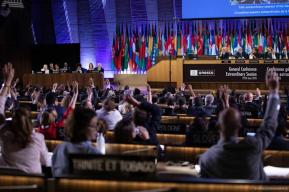News
UNESCO's Niels Bohr Gold Medal awarded to prominent researchers in 2013

An Open World: Science, Technology and Society in the Light of Bohr's Thoughts
5 December 2013 – Three of the world’s leading researchers were awarded the UNESCO Niels Bohr Gold Medal today for their special contribution to groundbreaking research in physics.
M. G. Engida, Deputy Director-General of UNESCO said ‘This is a moment to celebrate the power of science to advance human knowledge and the power of this knowledge to advance the ideals of mutual understanding and peace’. The three researchers are: the CERN, the European Organization for Nuclear Research, the founder of Wikipedia, Jimmy Wales, and, the French physicist, Professor Alain Aspect.
- UNESCO was instrumental in the creation of the CERN. One of the most powerful examples of collaboration between CERN and UNESCO is the SESAME Project in Jordan -- bringing together scientists from Israel, Iran, Jordan, Turkey, Egypt, Pakistan, the Palestinian Authority and many more, showing the power of science to bring people together in peace.
- Wikipedia is a symbol of the age of connectivity and participation that we live in. Wikipedia is not just a tool -- it is the embodiment of a dream as old as humanity itself, as old as the Library of Alexandria…
- Professor Alain Aspect from France, for his contribution to understanding the non-locality of quantum mechanics.
The UNESCO Niels Bohr Gold Medal was established in 1985 to commemorate the centenary of Niels Bohr’s birth and was given out in 1998, 2005, 2010 and now in 2013. The medal is awarded to researchers who have made outstanding contributions to physics – research which, furthermore, has or could have a significant influence on the world.
UNESCO minted a medal in 1985 to commemorate the birth centenary of Niels Bohr, one of the most eminent scientists of the 20th century. Born in Denmark in 1885, he is considered the father of quantum physics and his thinking on the ethics of science has infused UNESCO’s work. The medal was sculpted by Siv Holme-Muse of Sweden and struck by the Paris Mint, the obverse bearing the profile of the 1922 Nobel Prize laureate repeated six times.







